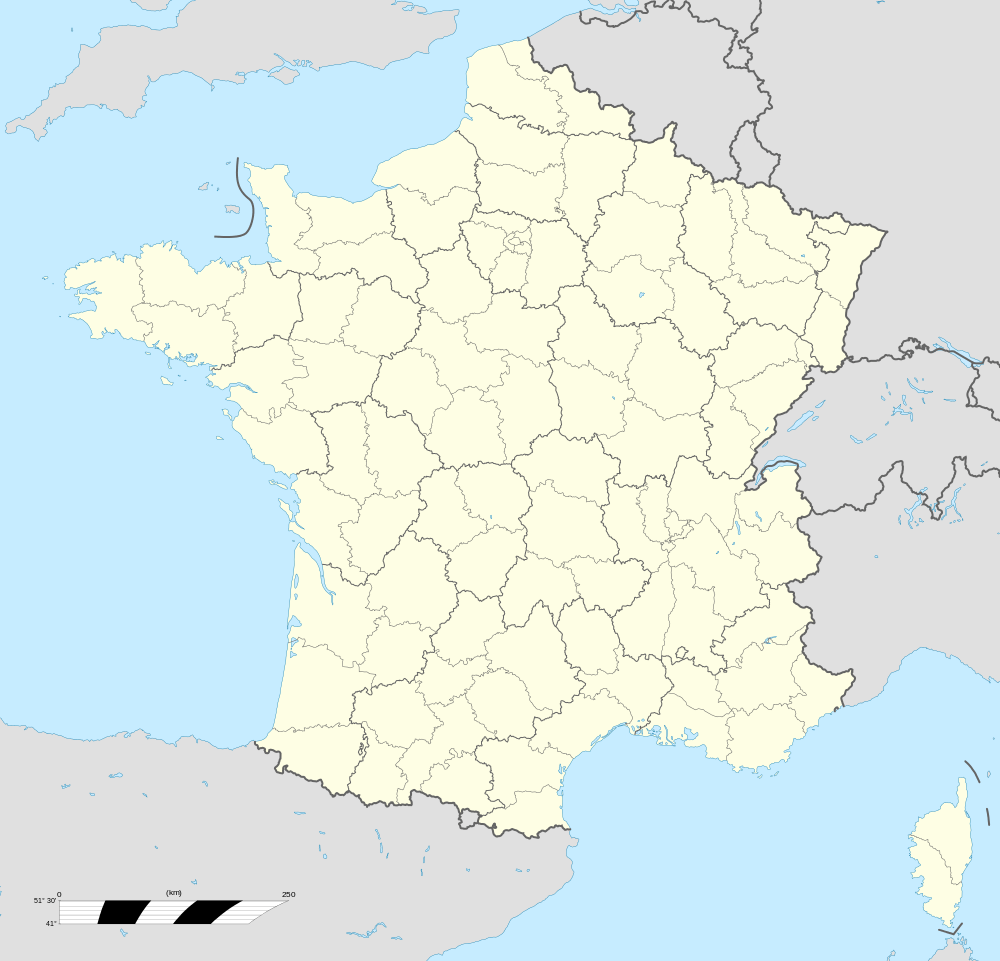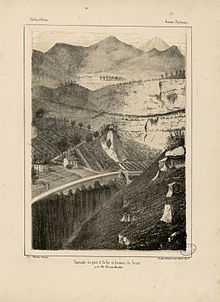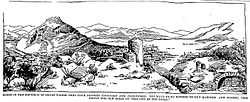Goust
| Goust | |
|---|---|
| Hamlet | |
|
Artist's rendering of Goust and its ruined "City of the Hills" (1899). | |
 Goust | |
| Coordinates: 42°57′N 00°27′W / 42.950°N 0.450°WCoordinates: 42°57′N 00°27′W / 42.950°N 0.450°W | |
| Country | France |
| Region | Aquitaine |
| Department | Pyrénées-Atlantiques |
| Arrondissement | Oloron-Sainte-Marie |
| Canton | Laruns |
| Commune | Laruns |
| Area | |
| • Total | 2.5 km2 (1.0 sq mi) |
| Goust | |||||
| Unrecognized state | |||||
| |||||
| Capital | Not specified | ||||
| Languages | Béarnese, French | ||||
| Religion | Roman Catholic | ||||
| Government | Republic | ||||
| History | |||||
| - | Established | 1648? | |||
| - | Disestablished | ? | |||
| Area | |||||
| - | 1865 | 2.5 km² (1 sq mi) | |||
| Population | |||||
| - | 1865 est. | 59 | |||
| Density | 23.6 /km² (61.1 /sq mi) | ||||
| - | 1885 est. | 61 | |||
| - | 1900 est. | 150 | |||
| Currency | French franc | ||||
Goust is a hamlet in the Pyrénées-Atlantiques department of southwestern France. It was never formally annexed by France, so even as late as the 19th century, visitors described it as an independent republic.[1] Noted for its centenarians, one pensioner was reported to have reached the age of 123,[2][3] although this is unconfirmed.
Geography

Goust is located on the territory of the commune of Laruns. It occupies one square mile on a plateau at the southern (upper) end of the valley of the Gave d'Ossau in the Western Pyrenees, across the river from Eaux-Chaudes. At an elevation of 995 m/3264 ft, it is accessible only by a narrow mountain footpath across the Pont d'Enfer ("Bridge of Hell"). The nearest town is Laruns in the valley below.
The community is made up of 10-12 households, with a population fluctuating between 50 and 150 residents. The traditional economy was based on animal husbandry, wool, and silk production, augmented more recently by tourism. All baptisms, weddings, and burials are performed at the Catholic Church in Laruns.[4]
Due to its isolated situation, the inhabitants of Goust evolved a curious funeral custom: the deceased was placed in a coffin and sent down the mountainside via a specially-constructed chute, to be collected at the bottom for burial in the Laruns cemetery.
History
Self-governing for centuries, Goust's independence was allegedly recognized by France and Spain since at least 1648. The government consisted of a Council of Ancients composed of three to twelve citizens, who elected a President for a term of five years.[5][6][7]
In 1896 the president reportedly proclaimed a ban on publication of any newspaper without executive authorization, which led to an uprising of the citizens.[8]
Although never formally annexed, Goust has not recently asserted its claim to independence, so is de facto a part of France, and generally recognized as such.
Jean-François Samazeuilh (1858) attributes the claims of Goust's independence to an 1827 description by the former French Minister of the Interior Joseph Lainé. Samazeuilh says that Lainé was speaking metaphorically when he labeled Goust a "republic," and that other writers took this literally ("on a pris au sérieux cette fantaisie du spirituel écrivain"). He then provides a long quotation from the Album Pyrénéen which demonstrates the fallacy of this interpretation—for example, the residents of Goust pay taxes to the government in Laruns.[9]
See also
- List of extinct states
- List of historical unrecognized countries
- Former countries in Europe after 1815
- Longevity claims
References
- ↑ Lainé, Joseph (1827). "Lettres écrites des Eaux-Bonnes, à M. le marquis de V***; sixième lettre". Annales de la littérature et des arts 29. Paris. pp. 15–20. Retrieved 2012-01-02. (Lainé is mentioned as "Lal***," but his name is known elsewhere, cf. Louis Lacour (1863). Annales du bibliophile: du bibliothécaire et de l'archiviste, Volumes 1-16. p. 12.)
- ↑ Palma-Cayet, Pierre-Victor (1609). Chronologie septenaire de l'histoire de la paix entre les Roys de France et d'Espagne. Paris: Jean Richer. p. 445. Retrieved 2010-07-13.
- ↑ Batcave, Louis (1896). "Un centenaire extraordinaire de Goust". Études historiques et religieuses du Diocèse de Bayonne : comprenant les anciens diocèses de Bayonne, Lescar, Oloron et la partie basque et béarnaise de l'ancien diocèse de Dax (Imprimerie Vignancour): 317. Retrieved 2012-01-02.
- ↑ "Mitkä ovat maailman pienimmät valtiot?". Päivälehti (in Finnish) (50). 21 February 1897. p. 4. Retrieved 17 July 2014.
- ↑ "Smallest Republic in the World," Dallas Morning News, August 15, 1896, p 8
- ↑ "Pinhead Republics". The Democratic Standard. April 20, 1894. p. 3. Retrieved 2011-07-15.
- ↑ Post, Louis F., ed. (Feb 3, 1900). "Little Nations Little Known". The Public: A journal of democracy 2 (96): 15–16. Retrieved 2011-02-18.
- ↑ "Fighting for Journalism". Boston Daily Globe. July 14, 1896. p. 8. Retrieved 2011-07-15.
- ↑ Jean-François Samazeuilh (1858). Voyage de Bayonne aux Eaux-bonnes et aux Eaux-chaudes, en passant par la Basse-Navarre et la Soule. Bayonne. pp. 210–211.
Further reading
- Dix, Edwin Asa (1890). A Midsummer Drive through the Pyrenees. New York & London: G. P. Putnam's Sons. pp. 168–178.
- Eyriès, Jean-Baptiste Benoît; Victor Adolphe Malte-Brun (1828). "Hameau de Goust, dans les Pyrénées". Nouvelles annales des voyages, v. 37. Paris: Librairie de Gide fils. pp. 109–113. (A reprint of Lainé)
- Despourrins, Cyprien (1844), Itinéraire de Pau aux Eaux-Bonnes et aux Eaux-Chaudes. Imprimerie de È. Vignancour.
- Moreau, Adolphe (1863), Pau, Eaux-Bonnes, Eaux-Chaudes: bains, séjour, excursions, pp. 300–304.
- Palassou, Pierre Bernard (1815), Mémoires pour servir à l'histoire naturelle des Pyrénées et des pays adjacents, p. 22.
- Perret, Paul (1882), Les Pyrénées françaises, vol. 2: Le Pays Basque et la Basse-Navarre, pp. 390–391.
- Robb, Graham (2007), The Discovery of France, pp. 19–21.
- "An Unknown Republic". Chambers's Edinburgh Journal 10 (244): 165–166. Sep 2, 1848.
- Vivien de Saint-Martin, Louis (1875 ff), Nouveau Dictionnaire de Géographie Universelle, vol 2, p. 511.
- Walsh, William S. (1913) A Handy Book of Curious Information, J.B. Lippincott Company, Philadelphia. pp. 732–733.
